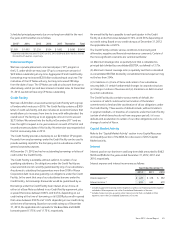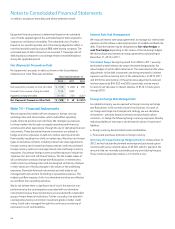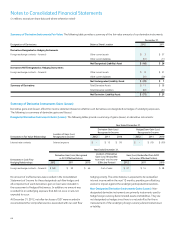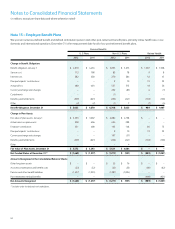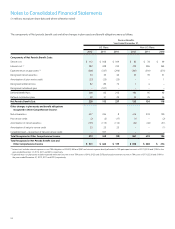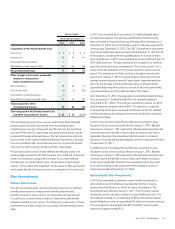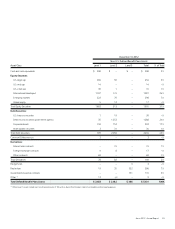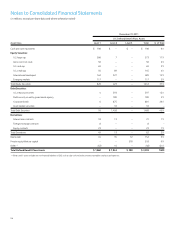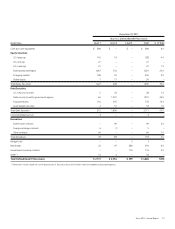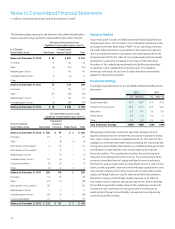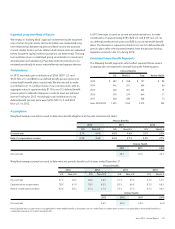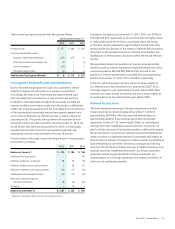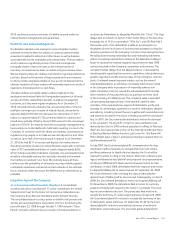Xerox 2012 Annual Report Download - page 95
Download and view the complete annual report
Please find page 95 of the 2012 Xerox annual report below. You can navigate through the pages in the report by either clicking on the pages listed below, or by using the keyword search tool below to find specific information within the annual report.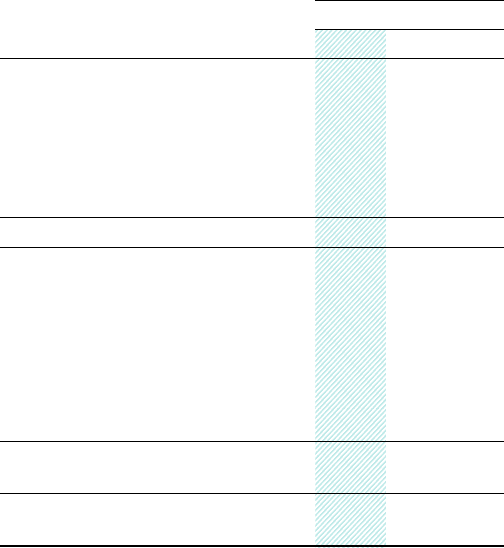
93Xerox 2012 Annual Report
Retiree Health
Year Ended December 31,
2012 2011 2010
Components of Net Periodic Benefit Costs:
Service cost $ 9 $ 8 $ 8
Interest cost 42 47 54
Recognized net actuarial loss 1 – –
Amortization of prior service credit (41) (41) (30)
Net periodic benefit cost 11 14 32
Other changes in plan assets and benefit
obligations recognized in
Other Comprehensive Income:
Net actuarial loss 18 25 13
Prior service credit (6) (3) (86)
Amortization of net actuarial loss (1) – –
Amortization of net prior service credit 41 41 30
Total recognized in Other
Comprehensive Income 52 63 (43)
Total recognized in Net Periodic Benefit Cost
and Other Comprehensive Income $ 63 $ 77 $ (11)
The net actuarial loss and prior service credit for the defined benefit
pension plans that will be amortized from Accumulated other
comprehensive loss into net periodic benefit cost over the next fiscal
year are $106 and $(2), respectively, excluding amounts that may be
recognized through settlement losses. The net actuarial loss and prior
service credit for the retiree health benefit plans that will be amortized
from Accumulated other comprehensive loss into net periodic benefit
cost over the next fiscal year are $2 and $(43), respectively.
Pension plan assets consist of both defined benefit plan assets and
assets legally restricted to the TRA accounts. The combined investment
results for these plans, along with the results for our other defined
benefit plans, are shown above in the “actual return on plan assets”
caption. To the extent that investment results relate to TRA, such results
are charged directly to these accounts as a component of interest cost.
Plan Amendments
Pension Plan Freezes
Over the past several years, we have amended several of our defined
benefit pension plans to freeze current benefits and eliminate
benefits accruals for future service. In certain plans we are required
to continue to consider salary increases in determining the benefit
obligation related to prior service. The following is a discussion of these
amendments and their impact on our primary defined benefit pension
plans.
In 2011, we amended all of our primary U.S. defined benefit plans
for salaried employees. Our primary qualified plans had previously
been amended to freeze the final pay formulas within the plans as of
December 31, 2012, but a cash balance service credit was expected to
continue post December 31, 2012. The 2011 amendments fully freeze
any further benefit and service accrual after December 31, 2012 for all
of these plans, including the non-qualified plans. As a result of these
plan amendments, in 2011 we recognized a pre-tax curtailment gain of
$107 ($66 after-tax). The gain represents the recognition of deferred
gains from other prior year amendments (“Prior service credits”) as a
result of the discontinuation of any future benefit or service accrual
period. This amendment will also result in a change in amortization
period as of January 1, 2013 for actuarial gains and losses from the
average remaining service period of participants (approximately ten
years) to the average remaining life expectancy of all participants
(approximately thirty-three years) as a result of all participants being
considered inactive as of the effective date of the freeze.
As of December 31, 2012, the aggregate accumulated actuarial losses
for our primary U.S. Defined Benefit Plans for salaried employees
amounted to $1.1 billion. This change is expected to reduce our 2013
pension expense by approximately $47. This reduction is expected
to be partially offset by an increased contribution to the U.S. defined
contribution plan as all employees have been transferred to that plan
following the freeze.
In 2011, the Canadian Salary Pension Plan was amended to close
the plan to future service accrual effective January 1, 2014. Benefits
earned up to January 1, 2014 will not be affected and participants will
continue receive the benefit of future salary increases to the extent
applicable; therefore, the amendment did not result in a material
change to the projected benefit obligation at the re-measurement date
of December 31, 2011.
In 2009, the U.K. Final Salary Pension Plan was amended to close
the plan to future service accrual effective January 1, 2014. Benefits
earned up to January 1, 2014 will not be affected and participants will
continue receive the benefit of future salary and inflation increases
to the extent applicable; therefore, the amendment does not result
in a material change to the projected benefit obligation at the re-
measurement date of December 31, 2009.
Retiree Health Plan Amendments
In 2010, we amended our domestic retiree health benefit plan to
eliminate the use of the Retiree Drug Subsidy that the Company
receives from Medicare as an offset to retiree contributions. This
amendment was effective January 1, 2011. The Company instead
decided to use this subsidy to reduce its retiree healthcare costs. The
amendment resulted in a net decrease of $55 to the retiree medical
benefit obligation and a corresponding $34 after tax increase to equity.
This amendment reduced both the 2012 and 2011 retiree-health
expenses by approximately $13.




